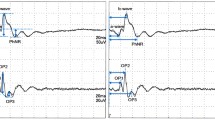Abstract
Retinal survival and revival times were measured in cats and rabbits at controlled retinal temperatures. While the great difference between b-wave survival times in cats and rabbits was confirmed, the revival times were distinctly shorter (30 min) than those previously found.
Similar content being viewed by others
References
Böck J, Bornschein H and Hommer K (1959) Die Überlebenszeit der a-welle im Elektroretinogramm des Menschen. Albrecht von Graefes Arch Ophthalmol 161:6–15.
Böck J, Bornschein H and Hommer K (1963a) Die Wiederbelebungszeit der menschlichen Netzhaut. Eine elektroretinographische Studie. Albrecht von Graefes Arch Ophthalmol 165: 437–451.
Böck J, Bornschein H and Hommer K (1963b) Der Einfluß verschiedener Reizparameter auf Überlebens- und Erholungszeit des ERG. Albrecht von Graefes Arch Ophthalmol 166: 315–330.
Böck J, Bornschein H and Hommer K (1964) Die Erholungslatenz der Helligkeitsemp-findung und des Elektroretinogramms nach retinaler Ischämie. Albrecht von Graefes Arch Ophthalmol 167: 276–283.
Bornschein H (1958) Spontan- und Belichtungsaktivität in Einzelfasern des N. opticus der Katze. I. Einfluß kurzdauernder retinaler Ischämie. Z Biol 110: 210–222.
Bornschein H (1959) Der Einfluß der Reizfrequenz auf die Überlebenszeit des skotopischen ERG. Pflügers Arch Ges Physiol 270: 184–194.
Bornschein H and Charif SE (1959) Die Bedeutung konstanter Temperaturbedingungen für ERG-Untersuchungen bei Kleinsäugern. Experentia 15:296–300.
Bornschein H and Zwiauer A (1952) Das Elektroretinogramm des Kaninchen bei experimenteller Erhöhung des intraokularen Druckes. Albrecht von Graefes Arch Ophthalmol 152, 527–531: 527–531.
Brown KT and Watanabe K (1962) Rod receptor potential from the retina of the night monkey. Nature 196:547–550.
Burian HM (1953) Electroretinography and its clinical application. Arch Ophthalmol 49:241–256.
Foulds WS and Johnson NP (1974) Rabbit electroretinogram during recovery from induced ischemia. Trans Ophthalmol Soc UK 94:383–393.
Goder G, Ulrich W-D, Plath H and Gutewort G (1970) Funktionelle und morphologische Veränderungen der druckischämischen Kaninchenretina. Kongreßbericht Ges Augenärzte DDR, 7 bis 9.5, 354–365.
Goder G and Ulrich W-D (1973) Fluoreszenzmikroskopische Untersuchungen an druckischämischen Kaninchennetzhäuten. Gegenbaurs Morphol Jahrb 119:72–75.
Guist G (1926) Klinische Betrachtungen und experimentelle Ergebnisse zur Frageüber die Erholungsfähigkeit der Netzhaut nach Unterbrechung der Blutzirkulation (monograph). Abndlg Geb Augenheilkd, Heft 1.
Hamasaki DI and Fujino T (1966) The effect of high intraocular pressure on the ERG, ISCERG News Letter 7/1, 11, 1966
Hamasaki DI and Kroll AJ (1968) Experimental central retinal artery occlusion: an electrophysiological study. Arch Ophthalmol 88:243–248.
Hanitzsch R and Bornschein H (1965) Spezielle Überlebensbedingungen für isolierte Netzhäute verschiedener Warmblüter. Experentia 21:484–485.
Hayreh SS and Weingeist TA (1980) Experimental occlusion of the retina. IV: Retinal tolerance time to acute ischemia. Br J Ophthalmol 64:818–825.
Hirsch H and auSchneider M (1966)Zur Durchblutung und O2-Versorgung der Netzhaut.Concilium Ophthalmologicum Germaniae, München, 122–137.
Hoff M and Gouras P (1973) Tolerance of mammalian retina to circulatory arrest. Doc Ophthalmol Proc Series 2, 57–63.
Horsten GPM and Winkelman JE (1957a) Effect of temporary occlusion of the aorta on the electroretinogram. Arch Ophthalmol 57:557–565.
Horsten GPM and Winkelman JE (1957b) Relationship between intraocular pressure, blood pressure and electroretinogram. Acta Physiol Pharmacol Neerl 6:586–596.
Johnson NF and Foulds WS (1978) The effect of total acute ischemia on the structure of the rabbit retina. Exp Eye Res 27:45 -59.
Noell WK (1951) Site of asphyxial block in mammalian retina. J Appl Physiol 3:489–500.
Papst W and Heck J (1957) Der Erholungsverlauf des Elektroretinogramms nach intraocularer Ischämie und seine Beeinflussung durch Hypoglykämie. Graefes Arch Ophthalmol 159:52–59.
Popp C (1955) Die Retinafunktion nach intraokularer Ischämie. Albrecht von Graefes Arch Ophthalmol 156:395–403.
Reimann J and Ulrich W.D (1979) ERG and VEP in ischemia of the rabbit eye. Doc Ophthalmol Proc Series 23.
Reinecke RD, Kuwabara T, Cogan DC and Weis DR (1962) Retinal vascular patterns. V. Experimental ischemia of the cat eye. Arch Ophthalmol 47:470–475.
Schubert G and Bornschein H (1952) Elektroretinogramm und Helligkeitswahrnehmung bei Hypoxie. Wien Z Nervenheilkd 4:393–399.
Ulrich W-D (1976) Grundlagen und Methodik der Ophthalmodynamometrie. Ophthalmodynamographie, Temporalisdynamographie. Abhdlg Gebiete Augenheilk (monograph), 44, 152 pp.
Ulrich W-D (1983) The influence of retinal temperature on survival and revival times of the rabbit retina. Unpublished
Ulrich W-D and Wündsch L (1970) Der Barbiturateffekt im ERG als Nachweis der Vollständigkeit einer Druckischämie. Dtsch Ges Klin Med 70:351–353.
Vassileva PI and Dabov SB (1976) Changes in the glycogen content and the electroretinogram in retinal ischemia experimentally-induced in rabbits. In: Vision and Circulation, ed: Cant J.S. London: Henry K 66–78
Wegner W (1928) Die Funktion der menschlichen Netzhaut bei experimenteller ischemia retinae. Arch Augenheilkd 98:514–564.
Weiss H (1972) The carbohydrate reserve in the vitreous body and retina of the rabbit's eye during and after pressure ischemia and insulin hypoglycemia. Ophthalmic Res3:360–371.
Weiss H and Kosmath B (1973) Der Milchsäuregehalt im Glaskörper des Kaninchenauges während und nach Druckischämie. Graefes Arch Klin Exp Ophthalmol 186:105–109.
Wündsch L (1975) experimentell-kritische Studie zum Problem der retinalen Ischämie. Graefes Arch Klin Exp Ophthalmol 197:241–253.
Wündsch L and Ulrich W-D (1970) Increased intraocular pressure and barbiturate effect on the ERG of cats. In: Symposium on Electroretinography: proceedings of the VIII ISCERG Symposium, Pisa (Italy) Ed: Wirth A.Pisa: Pacini, 384–389.
Author information
Authors and Affiliations
Rights and permissions
About this article
Cite this article
Ulrich, W.D., Reimann, J. Survival and revival times of the retina: ERG studies at total ocular ischemia in rabbits and cats. Doc Ophthalmol 63, 91–99 (1986). https://doi.org/10.1007/BF00153016
Issue Date:
DOI: https://doi.org/10.1007/BF00153016




